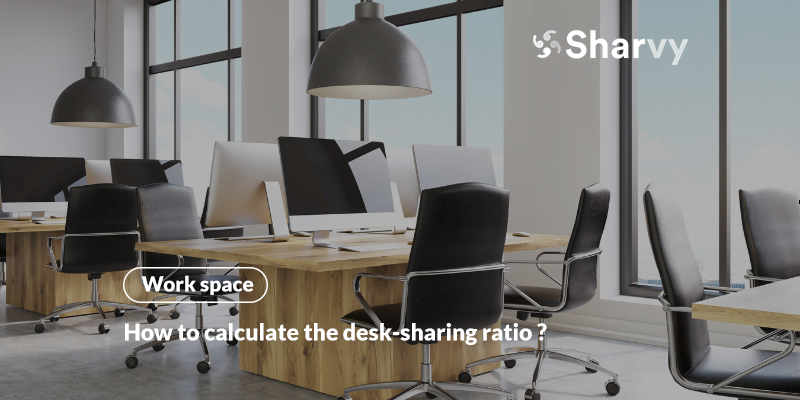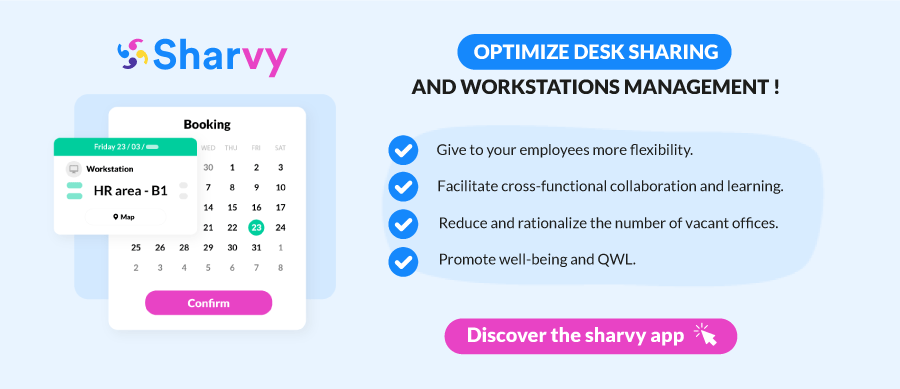The Covid-19 crisis was the driving force behind the growth of teleworking, but in the end, it only revealed a change that had already begun in the world of work.
The evidence is clear : nomadism is gaining ground in companies and gradually reducing the influence of fixed workstations. As a result, the flex office is now, more than ever, taking on its whole meaning and inviting itself into our offices.
Bringing both promises and risks, the deployment of the flex office accentuates the need to orchestrate uses and rethink work spaces within companies. At the same time, and to gain the support of employees, its implementation also requires the company to think about its workstation pooling rate. In other words, consider the calculation of the desk-sharing ratio.
However, how do you go about it? Focus on its calculation (and many bonus tips) in this article!
What is the desk-sharing ratio? – Definition
The desk-sharing ratio, also called the “flex-office rate” or the “workstation sharing rate,” is the ratio between the number of available individual workstations and the number of employees in a company.
However, what is its purpose?
In recent years, hybrid working has become the norm, and we are experiencing a massive and uninhibited adoption of teleworking.
As a result, companies are questioning the role of the office, as well as its occupation. In addition, many are seeing a lot of vacant space, which they are paying for at a high price. In this context, flex-office has naturally appeared in the real estate debate.
Flex-office advocates optimize space by matching human presence with the surface area used. As a result, companies no longer think in terms of one workstation per person!
This is why, according to a study carried out in 2021 by JLL, it is widespread for companies to opt for a 10:7 ratio (ten employees for seven offices). As a result, there is no doubt that the pandemic has changed the face of office work and has only revealed the growing need to reconfigure corporate spaces, no longer in terms of people but of uses.
How to calculate the desk-sharing ratio? 3 golden rules!
Calculating the desk-sharing ratio is a challenging task.
The reason for this is that if the ratio is too low (and is equivalent to 0.9 = 9 workstations for every 10 employees), then there is a risk that employees will become sedentary again by taking over new offices. On the other hand, with such a ratio, it is evident that the employees of this company will be able to find an individual workspace easily.
On the other hand, if the desk-sharing ratio is too high (and equals 0.5 = 5 workstations for every 10 employees), then in this case, the company may be faced with the disengagement of its employees. As a result, it will undoubtedly have to invest in third places (corpoworking, coworking space, etc.). This was probably not the initial objective in opting for the flex office.
So, how to choose the correct desk-sharing ratio? Here are 3 golden rules to apply.
1. Consider the number of days per week that you telework.
Remember that the telework policy directly influences the calculation of your desk-sharing ratio. So, take the time to define the usage, and to determine the (average) number of days your employees telework, if you still need to do so.
At the same time, be aware that a desk-sharing ratio of 0.8, i.e. 8 workstations per 10 employees, is the flex-office ratio that can naturally be implemented without teleworking. In other words, only with a “classic” company cycle (business travel & training days, RTT, illness, absences, etc.).
Nevertheless, it is evident that the use of telework facilitates the adhesion of your employees to the flex office (or flex desk), notably because it reduces the feeling of “empty offices.” But also because it will allow you to reach a financially attractive desk-sharing ratio.
2. Study your business categories, profiles, and uses.
This may seem obvious, but it is worth remembering: if you know of a company in your circle of acquaintances where the transition to the flex office has gone very well, with a desk-sharing ratio of 0.7 – there is often a risk of wanting to copy the same ratio.
Well, that’s a big mistake! The reason is apparent : a high desk-sharing ratio will be justified for a company whose employees are mainly salespeople and/or consultants since they are regularly moving. On the other hand, this same rate will not be appropriate for different job categories (HR, Business Developer, Marketing, etc.).
Therefore, to determine the workstation pooling rate that corresponds to your company, do not neglect your sector of activity, your “business” categories, and the daily lives of your employees. These factors directly influence your desk-sharing ratio.
3. Be sure to monitor various indicators to anticipate your current and future needs.
The third golden rule for determining a desk-sharing ratio consistent with your current and future needs is to monitor various indicators. For example, take the time to :
- Accurately assess the average occupancy rate of your workspaces. To do this, consider the use of telecommuting, the number of days off and holidays for everyone, and the average number of business trips per week.
- Observe whether the remote/presence-based organization of two employees means that they never cross paths. If this is the case, they should share an office.
- Take stock of the number of employees, possibly anticipating growth in numbers. Ensure you also consider peak and off-peak periods during the year. Finally, and if you have already implemented a desk booking tool, such as Sharvy, it is interesting to observe the reservation rate of an individual workstation, a workstation within an open space, rooms, etc. Then look at the trends that emerge.
These indicators will guide your decisions and allow you to justify them to your employees.
What is the use of measuring the desk-sharing ratio?
Measuring your desk-sharing ratio is not only a very important indicator to calculate to excel in your flex-office strategy. But it is also a way to determine whether or not your company should use a desk booking tool.
For example, a company with a flex-office rate of 0.9 has nothing to worry about, as employees will not really have any problems finding a workstation when they arrive on site. In this case, the reservation of workspace is not only less, but will also be totally counterproductive.
Obviously, in the above situation, the risk of deploying a reservation tool is that employees will not use it. A few good students will take the plunge into booking, but the majority will not do so in the long run. Indeed, why reserve a workspace when they are sure to find one every morning?
At the same time, the tool can lead to a feeling of frustration. In particular, when an employee who has not made a reservation finds himself in a space reserved by another. The good employee will have to negotiate to get his or her place back, which in some cases can, unfortunately, lead to tension.
This is why we recommend a desk booking tool when your desk-sharing ratio is less than or equal to 0.8.
Are you looking for a desk booking tool? Ask for a demonstration of the Sharvy solution!
Office use vs. occupancy : should we rely solely on the desk-sharing ratio?
The answer, of course, is no. Looking at the occupancy of workspaces by measuring the desk-sharing ratio is one thing: knowing whether they are well used is another.
This is why, to excel in the deployment of flex-office within your organization, it is crucial to define a real estate strategy that harmoniously reconciles the occupation and use of your spaces.
Therefore, to optimize the use of your workspaces in the long term, you must ensure they offer everything your employees need. This is especially important nowadays, as meeting the high expectations of your employees is essential. Not only does this allow you to improve the employee experience, but it is also an excellent way to retain your best talent. So, to achieve this, make sure you :
1. Study and understand the practices & needs of your staff.
Today, many employees want to free themselves from the time and space constraints of the canonical work model : in particular, the fixed 9 to 6 working days, presenteeism, and designated offices.
The CIPD study, conducted in 2022, highlights a growing demand for flexibility. Indeed, for most workers, the freedom to choose the place of work according to their needs is a significant demand that employers must now listen to and consider, as well as the growing desire for autonomy, with the implementation of a teleworking policy, if this is not already the case.
However, the needs may vary from one employee to another, depending on the department/pole they occupy, their tasks, and their aspirations. Therefore, it is necessary to observe the practices of employees, to understand their habits and needs.
There are many ways of doing this. While not a chore for your employees, the quickest is to carry out a questionnaire to be distributed internally. The second alternative is to conduct individual or group interviews with your employees. This method is just as effective but requires more time.
2. Provide various spaces : meeting rooms, open spaces & collaborative spaces, etc.
For many employees, well-being at work is synonymous with ergonomic workplaces.
This is especially true since more and more employees are juggling daily tasks. For example, for one task, they may need to do a brainstorming session and prefer to sit in a meeting room. For other tasks, such as creating and/or writing content, they will choose a quieter workspace, away from the noise of the open space, for example.
This is why more than partitioned offices or open space is required to boost the commitment and productivity of your employees. So, to optimize the use of your spaces in the long term, and to ensure that they are adapted to everyone’s needs, make sure you create different types of spaces, such as :
- Acoustic booths
- Formal and informal meeting rooms
- A break room and/or quiet alcoves
- Desk sharing and/or flex office areas
- Outdoor terraces
- Possibly coworking areas, etc.
3. Improve your workspace management.
Be careful about one thing : the desk-sharing ratio can (sometimes) crystallize tensions.
The reason is apparent : with the introduction of the flex office, employees are no longer sure to find a free workstation once they are on site. This is all the more likely when the desk-sharing ratio is less than 0.7, i.e. 7 workstations per 10 employees.
Consequently, this new work organization can become counterproductive if it is poorly supervised and generates stress and frustration. This is why it is necessary to be equipped to rethink your workspaces while avoiding these pitfalls.
In this respect, the Sharvy solution can be your right hand. Through a web & mobile application, you offer your employees the possibility to book a workstation or a zone, before they come on-site. In addition, by allowing desk booking within your company, you avoid congestion and guarantee your employees a serene work environment.
With such a tool, your employees gain flexibility and can plan their presence in the office in advance, directly impacting their productivity. This is why many companies now choose the combination of face-to-face and distance learning.
At Sharvy, we would be delighted to demonstrate the solution and support you. Our experts are here to help and advise you.
In conclusion
The deployment of the flex-office and the implementation of a desk-sharing ratio may upset the practices and habits of employees. Therefore, a test & learn phase with the teams keen on this type of model may be justified before the general roll-out.
However, remember that the desk-sharing ratio can be controlled over time. For example, it can be reduced as telework develops, either by selling off certain areas that are no longer needed or not taking on additional measurements when staff numbers increase.
Therefore, as companies adapt their spaces for flex-office, they focus on the flexibility of spaces and the quality of work life. This adaptation meets the needs of nomads and startups, with working methods that favor shared offices and coworking spaces.
A question? Check the following FAQ!
How can employees' fears be overcome if the company determines a high desk-sharing ratio?
Implementing flex-office and, in correlation, calculating a desk-sharing ratio must be thought through on the global scale of a working environment. If setting a high desk-sharing ratio would benefit your company, defuse some resistance, for example, by providing support for change.
To overcome employees’ fears, a pilot project can be launched with a few teams keen on this type of model. A Test & Learn phase precedes the general roll-out and can help limit your employees’ apprehensions.
Do the implementation of flex-office and an appropriate desk-sharing ratio systematically reduce costs?
In reality, flex-office offers most companies a gain in surface area between 15% and 35%. Therefore, it is optimizing the square meters on which companies can save (in particular, by reducing the cost of rent and no longer paying additional charges and/or taxes).
However, remember that these economic gains will only be effective when the company gives back the square meters gained rather than redistributing and/or reorganizing them. So, it all depends on the initial objective.
How to adjust the desk-sharing ratio according to organisational or seasonal changes?
In an environment where flex-office and remote working vary, it is important to be able to adjust the desk-sharing ratio in response to organisational or seasonal changes. To achieve this, it is essential to carry out regular assessments of workspace utilisation, taking into account variations such as workload peaks, holiday periods, and changes in remote working practices. Using real-time space management tools can help gather accurate data on office occupancy. Based on this information, adjustments can be made proactively to ensure that the desk-sharing ratio remains optimal and responsive to the current needs of the company. This may include temporary adjustments for specific periods or more permanent revisions in response to long-term organisational changes.
Want to learn more? Check out our latest articles!
Flex office & its disadvantages : what you need to know before adopting it!
What is the flex office? How does it work? What are its drawbacks and how can you overcome them? Find the answers in this article!
The office as a branding tool : how can it reflect your corporate culture?
Is the office an underestimated branding tool? How can your spaces embody your culture & reinforce your brand image? Focus!
Flexible office solutions : how to adapt them to all generations ?
How can flexible office solutions adapt to the needs of different generations? What are the best strategies to implement? Focus!
Subscribe to our newsletter!
Resources
Contact us
+44 117 463 6990





